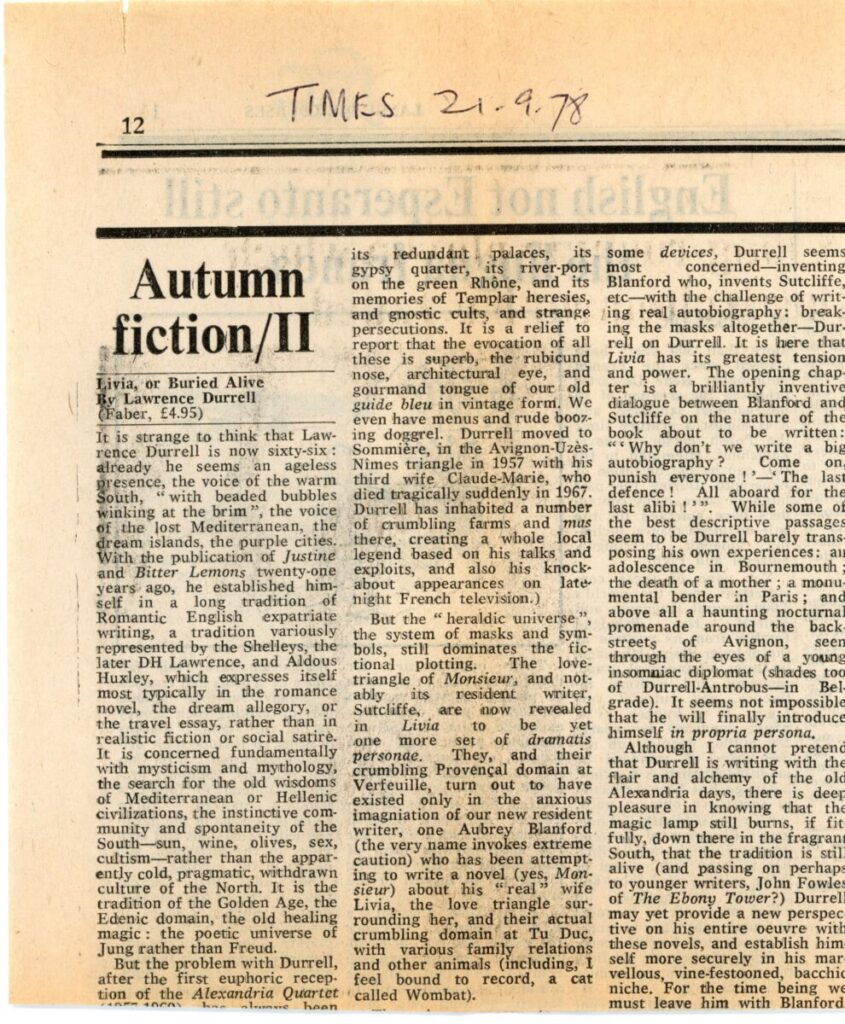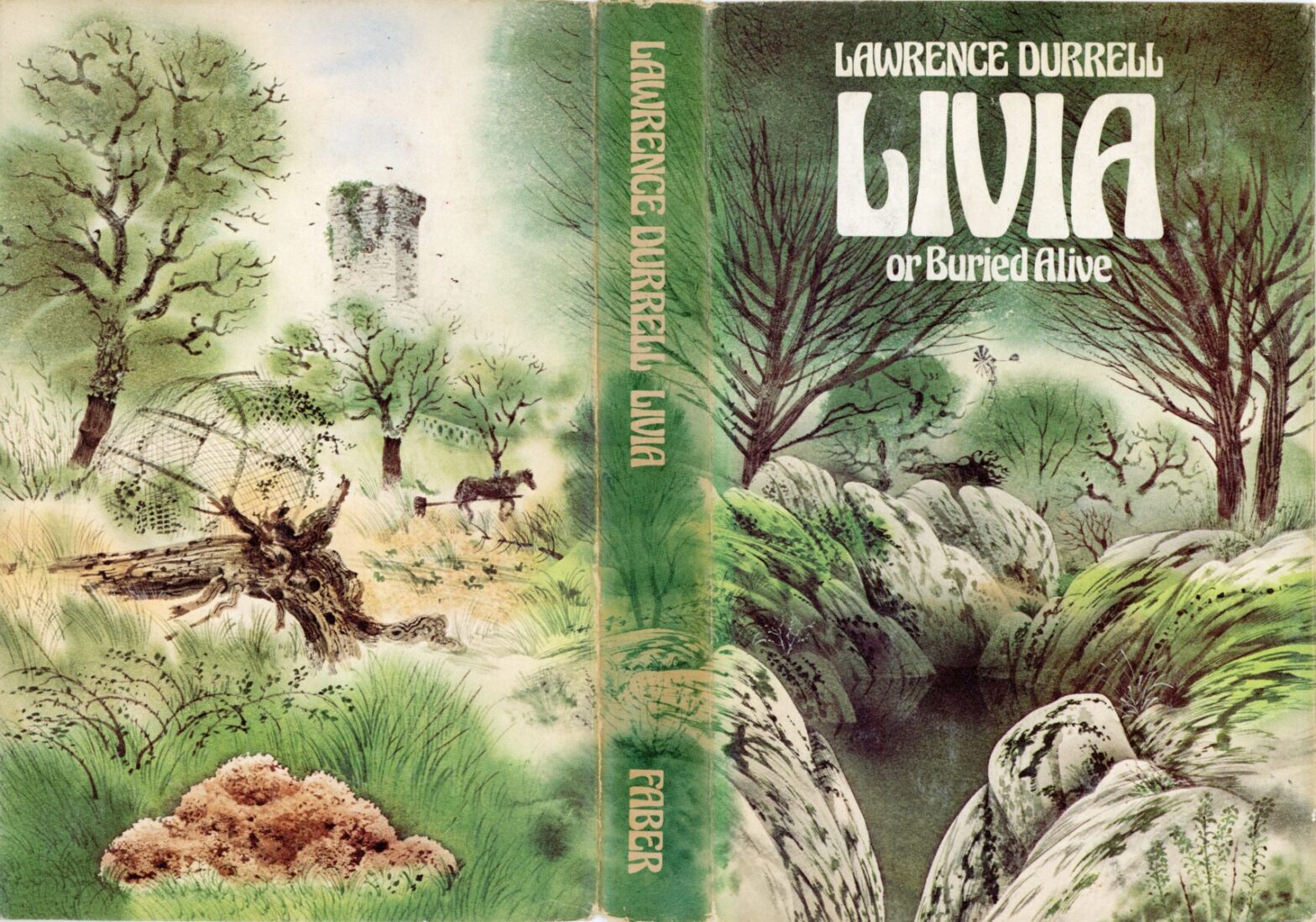It is perhaps the former cruciverbalist in me that prompted me to take up the Finnegan’s Wake challenge when I read that it contained sextilingual puns; or to persevere with Lawrence Durrell’s quincunx, of which “Livia, or Buried Alive” is the second book.
I failed Joyce’s challenge, giving up after 200 pages.
I am however getting somewhere with Durrell. This is because I am beginning to understand how metafiction works. Just as there was no sense in approaching Finnegan’s Wake as a chronological narrative this is the wrong way to appreciate Durrell’s work, which opens with a conversation between the narrator and one of his creations on the subject of autobiography, which in itself has echoes of our author’s own life story.
Set in the decade building up to the Second World War, I rather see the work as a series of tales concerning imaginary people who are not actually present, even when narrator Blanford is conversing with them. We have difficult early years; nocturnal wanderings around Avignon; discussions of fears about the conflict to come; a privileged wealthy libertine; some unpleasantly sordid revels suggestive of child abuse – all with Durrell’s glorious poetic prose. It is not easy, but so far is worth the effort.

Once again the Book Jacket is illustrated by David Gentleman’.
“David William Gentleman RDI (born 11 March 1930) is an English artist. He studied art and painting at the Royal College of Art under Edward Bawdenand John Nash. He has worked in watercolour, lithography and wood engraving, at scales ranging from platform-length murals for Charing Cross Underground Station in London to postage stamps and logos.
His themes include paintings of landscape and environmental posters to drawings of street life and protest placards. He has written and illustrated many books, mostly about countries and cities. He also designed a number of British commemorative postage stamps.” https://en.wikipedia.org/wiki/David_Gentleman

Slipped inside the front flap of this jacket is a browned cutting from The Times newspaper of 21st September 1978, on the basis of which I bought this first edition.

I’m afraid that I haven’t read any of the books mentioned. I managed thirty or forty pages of “Ulysses”. but that’s the closest I came.
Thanks a lot, John. That one I did manage to finish
I recently had a discussion with two men who are huge fans of James Joyce. They were fascinated by the tangle of language rather than put off by it, the way I am. Durrell’s writing sounds as though it has its own challenges, but perhaps not as great as Joyce’s. Striking cover!
You are right, Laurie – Durrell is much easier and actually more enjoyable. Joyce’s daughter, Lucia’s schizophrenia, has to have a bearing on “the tangle of language”
Yes, yes! Good point.
I was struck by the cover as well, Laurie!
The fact that Aubrey Blanford evokes Darley (and Pursewarden, for all that), and the mention of the ‘heraldic universe’ just plunked this on my to-be-read list, too. As rich as the Alexandria Quartet is, and as much as I’ve enjoyed it, it’s clearly time for a little exploring in the rest of Durrell’s work.
I’m pleased, Linda. I still have a copy of Clea which I may go back to after these. Thanks very much
How intriguing. I would have bought the book too.
Thank you very much, Sherry
I managed to work out ‘cruciverbalist’, knowing something of your history, but had to look up ‘sextilingual’ (which was not straightforward using my browser). I’m always happy to meet new or rarely seen words.
Thank you very much, Susan
Sextilingual is a word that seems to promise more than it actually delivers. But maybe that’s more to do with my mind being in the gutter. I keep meaning to read Durrell, but I mean to do so many things. Re-read Waugh, read Mrs Dalloway, which has been sitting patiently on my shelf for five or six years now . . .
Didn’t know Gentleman did so many stamps – some great stamps in the list, but a few of my non-favourites too. He also did the 2007 Abolition of the Slave Trade £2 keep checking your change – 8,445,000 were minted and they crop up regularly.
Thanks a lot, Quercus
🙂
I don’t think I’m up to tackling the book right now, but I’m glad you’re enjoying it. The cover art is beautiful, and I’m fascinated for some reason by the artist’s last name. I wonder if he was always told he had to live up to it.
Yes – it is rather a special name. Thanks very much, Merril
In college I listened to lectures by Jorge Luis Borges and had absolutely no clue as to what he was talking about. The idea of fiction being about fiction was a new idea. It helped immensely when someone put it into understandable words as you did with Durrell.
Thank you so much, Elizabeth
I’m not familiar with Durrell’s work. I get lost with complex chronology and narrative voices. Love the cover art.
Thanks very much, Rosaliene. The artist’s tile story at Charing Cross Underground station is really striking.
It’s heartening to see a reviewer go to the extra effort to read a book on its own terms. (Not always easy, I know.)
Thank you very much, Liz
You’re welcome, Derrick.
It’s confirmed. I need to read this kind of post in the morning. Thank you Derrick for sharing your mental acuity and mental brilliance.it’s raises the bar around here. 😉
Thank you so much, Val
I’m coping with a headache at the moment and “Noddy and Bigears” is a little taxing but hopefully I’ll get back to Durrell – Lawrence. I’ve done Gerald long ago.
Thanks very much, John. I do hope it is nothing serious
One more thought:- Would you ever write a post with the title “If you are limited for time these are the ten English novels you must read before you die.”
Definitely a thought
The title and the cover art capture my attention!
What a wonderful find in the front-flap!
I always enjoy your book reviews and author-talk.
(((HUGS))) ❤️
Thank you very much, Carolyn X
I looked up some of the artists work. Like other readers, I’m entranced by the cover. https://davidgentleman.com
Thanks very much, Alys
I am getting increasingly intrigued by Durrell, based on your reviews, Derrick. I think I’ll download and try to find an e-format with illustrations.
Thanks very much, Dolly
You are very welcome, Derrick.
As for “Ulysses”, I felt any literate human being must read it at some point, so struggled from front to merciful end over the “Weeks from Hell” it took. I confess I had to read the Cliff’s Notes summary of it later to find out what I’d endured…um…read. When the movie was made from it – a brave project! – I did watch it and enjoyed that more than the book. Did the movie follow the book well? I’ll never know.
Proust is another one of those authors I gave up on after the first 100 pages. I think he is another one of those authors you read at the right time in your life or you come away thinking, “What a gaseous twit!”
Thank you very much, Doug. I confess I haven’t seen the film, but did like Ulysses the book. Proust, I also enjoyed. I really like books concentrating on the process of life. The author I least like in that vein is Henry James
I’m more into the Latin American writers, Fuentes Macías and García Márquez in particular.
PS, Doug. Do try James Joyce’s Portrait of the Artist as a Young Man – before he started tangling language.
I remember reading that as a university student, though it probably would be a good plan to read it again.
I have been enjoying your reviews of Durrel’s work, Derrick. He is on my list.
Thank you very much, Lavinia
Crikey Derrick, I just about wore out Google with that post.????
🙂 Thanks very much, Lindsey
It sounds like not an easy book to read 🙂
It helped me when I gasped the idea of metafiction. Thanks very much, Ribana